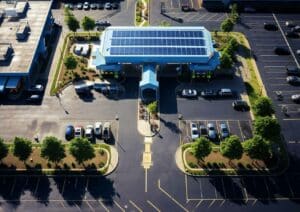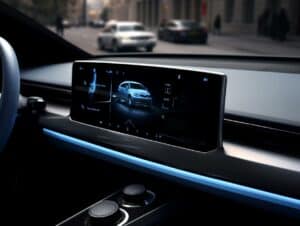As a forward-thinking business owner or property manager looking to cater to the growing number of electric vehicle (EV) drivers, understanding the various EV charging levels is essential in making an informed decision about which type of charging station to install at your facility.
Different charging levels offer distinct advantages in terms of speed and convenience, and choosing the right one can significantly enhance the value you provide to your customers or tenants, as well as the appeal of your property. Let’s explore the different charging options to determine the best solution for your needs as you consider investing in this cutting-edge infrastructure.
The Basics of EV Charging
Electric vehicles (EVs) have revolutionized the way we think about transportation, offering eco-friendly alternatives to traditional gasoline-powered cars. At the core of this revolution is the concept of EV charging. Understanding the basics of EV charging is essential for all prospective EV owners and anyone interested in the sustainable future of transportation. In this section, we delve into the fundamental aspects of EV charging.
How EV Charging Works
Charging an electric vehicle is fundamentally different from refueling a gasoline car. Instead of pumping liquid fuel, EVs rely on stored electricity in their batteries. The process involves transferring electrical energy from a power source to the vehicle’s battery for later use. Here’s a simplified breakdown of how EV charging works:
- Connection: Electric vehicles (EVs) are equipped with a charging port easily connected to various charging equipment. This port is designed to facilitate the smooth and efficient transfer of electricity between the charging station and the vehicle. By utilizing this technology, EV owners can rest assured that they can quickly and easily recharge their cars whenever needed without worrying about compatibility issues or other potential complications. Whether at home or on the go, the charging port on your electric vehicle is a reliable and convenient way to keep your EV powered up and ready to go whenever needed.
- Conversion: When an electric vehicle is charged from a Level 1 or Level 2 EV charger, the electricity from the charging station is first converted from AC (alternating current) to DC (direct current) before it enters the vehicle’s battery. The fastest charging type, Level 3 DC fast charging, utilizes direct current to power the EV. Using the more efficient DC charging method, electric vehicle owners can save time while reducing their carbon footprint.
- Battery Charging: When an electric vehicle receives direct current (DC) electricity, the battery is charged using a management system that ensures safe and efficient charging. This system effectively controls the charging process, guaranteeing that the battery is charged securely and efficiently.
Understanding Charging Levels: The Three Levels of EV Charging
Electric cars have various charging options, from slow overnight to high-speed DC charging. By understanding the three levels of EV charging and their differences, you can choose the right one for your needs.
Level 1 Charging: A Closer Look at Slow and Steady Charging
Level 1 (L1) charging, the most basic form of charging for electric vehicles (EVs), offers a convenient option for EV owners who prioritize cost-effectiveness and aren’t hurrying to replenish their batteries. It’s like a slow but steady journey that ensures your vehicle is ready for your next drive.
Description and Characteristics
Level 1 charging operates at a modest 120-volt connection, utilizing the familiar three-prong outlet commonly found in homes. When you plug your EV into a standard outlet, it draws around 12 amps of power, resulting in a maximum energy output of approximately 1.4 kilowatts (kW). While this might seem low compared to other charging levels, it serves a specific purpose in the EV charging landscape.
Suitable Use Cases
Level 1 charging is best suited for scenarios where time is not a pressing concern. If you mainly use your EV for occasional trips around town, commuting short distances, or as a secondary vehicle, Level 1 charging could fit seamlessly into your routine. It’s also viable to access a standard outlet near your parking spot and leave your vehicle plugged in overnight.
Charging Speed and Times
The trade-off for the convenience of Level 1 charging is its relatively slower speed. On average, Level 1 charging provides around 2 to 5 miles of range per hour. To put this into perspective, if you have an EV with a 200-mile range and start with an empty battery, it might take about 40 to 100 hours to achieve a full charge using Level 1 charging.
Advantages and Considerations
While Level 1 charging might not be the quickest option, it does have its merits. It’s an economical choice for EV owners who want to minimize upfront costs, as you can plug into a standard outlet without needing specialized equipment. Moreover, Level 1 charging is less demanding on your home’s electrical power consumption.
However, it’s essential to consider your usage patterns. Level 1 charging might not be suitable for those who rely heavily on their EVs for daily commuting or long journeys. Additionally, it’s crucial to remember that if your battery capacity is larger, the time required for a full charge will increase accordingly.
Users of Level 1 also often experience slow charging speeds and long waiting times, but again, they can benefit from the convenience of accessing a standard outlet. It’s essential to consider your EV usage patterns when deciding on a charging level to ensure you choose one that meets your needs.
Level 2 Charging: Striking a Balance Between Speed and Convenience
Moving up the charging hierarchy, Level 2 (L2) charging significantly boosts charging speed and convenience for electric vehicle (EV) owners. With a higher voltage and power output, Level 2 charging caters to a broader range of usage scenarios, making it a popular choice for many EV enthusiasts.
Description and Characteristics
Level 2 charging operates at 240 volts AC, double the voltage of Level 1 charging. This increased voltage allows for faster charging rates and more efficient energy transfer. To facilitate Level 2 charging, EV owners typically install a dedicated home charging station equipped with a higher-power charging cable and plug.
Common Installations
One of the significant advantages of Level 2 charging is its versatility. Dedicated Level 2 charging stations can be installed at various locations, including homes, workplaces, parking garages, and public charging stations. These stations require professional installation to ensure compliance with safety regulations and electrical codes, but they provide a seamless and reliable charging experience.
Charging Speed and Times
Level 2 charging significantly improves charging times compared to Level 1. On average, Level 2 charging offers a range of around 10 to 60 miles per hour. Plus, most EVs can get a nearly full charge within six to eight hours.
Advantages and Considerations
Level 2 charging strikes a balance between charging speed and convenience, making it suitable for many EV owners. It’s an excellent option for daily commuting, allowing you to recharge your EV overnight and start each day with a full or near-full battery. Level 2 charging can also be tailored to fit your specific needs by adjusting factors like charging power and scheduling.
When contemplating the use of Level 2 charging, it is crucial to factor in your driving habits. If you frequently embark on lengthy journeys that surpass your electric vehicle’s range, it’s worth noting that Level 2 charging may not offer the rapid charging times necessary for prolonged road trips.
In such instances, it may be prudent to contemplate DC fast charging (Level 3) as a viable alternative. This type of charging offers swift top-ups that can be beneficial for those who frequently drive for extended periods.
DC Fast Charging (Level 3): Powering Your EV at Lightning Speed
When time is of the essence, and you’re looking for a rapid charge to get you back on the road, DC Fast Charging (also known as Level 3 charging) is the solution. This high-powered charging option is designed for quick top-ups and is essential to the electric vehicle (EV) charging landscape, particularly for long journeys and road trips.
Description and Characteristics
DC Fast Charging operates on a much higher voltage than Level 1 and Level 2 charging, using direct current (DC) instead of alternating current (AC). These chargers are often found at dedicated charging stations and bypass the vehicle’s onboard charger, allowing for direct and rapid charging of the battery.
Rapid Charging Capabilities
One of the most significant advantages of DC Fast Charging is its rapid charging capability. These chargers can deliver a substantial amount of power to your EV’s battery in a short amount of time. This makes DC Fast Charging indispensable for EV owners who need to quickly replenish their battery during long journeys or when time constraints are a factor.
Charging Speed and Times
The speed at which your electric vehicle charges will differ based on the model and the specific DC Fast Charging station being used. Typically, DC Fast Charging can provide up to 60 to 80 miles of range after just 20 minutes of charging. For example, if your EV has a range of 200 miles and your battery is at 20%, you can attain an 80% charge in 30 to 45 minutes when using a Level 3 charger.
Advantages and Considerations
DC Fast Charging shines in scenarios where you’re on a road trip, need to charge to continue your journey quickly, or are in a rush. It’s the go-to option for topping up your battery when you have limited time at a charging station. DC Fast Charging stations are strategically placed along highways and urban areas to provide easy access for EV owners during long journeys.
However, it’s important to note that frequent use of DC Fast Charging, while convenient, can impact your battery’s long-term health. These high-power charges generate more heat, accelerating battery degradation over time.
Consider an EV owner who frequently relies on Level 3 charging for their daily commuting needs. The convenience of fast charging encourages them to use it extensively, as they’re always in a hurry. Over time, however, the frequent use of high-power Level 3 charging can lead to increased heat and stress on the battery pack. This may accelerate battery degradation, resulting in a decrease in overall battery capacity and range over the years. While Level 3 charging is great for quick top-ups on long trips, relying on it too heavily for routine charging can have long-term consequences on the health and performance of the battery.
Final Thoughts
Electric cars are an excellent, sustainable option for long and short commutes – but the charging is a significant concern. Ensuring you use the correct charging level for your EV will help you conserve resources and ensure your vehicle’s health and safety. It’s essential to do your research first to examine which charging type best suits your EV needs before getting started with higher-voltage chargers.
We recommend checking out all those safety guidelines we outlined earlier to ensure that you abide by them while utilizing any of the levels of EV charging. All in all, it’s essential to remember that charging your EV correctly will save you time and money and ultimately keep our planet healthier!







